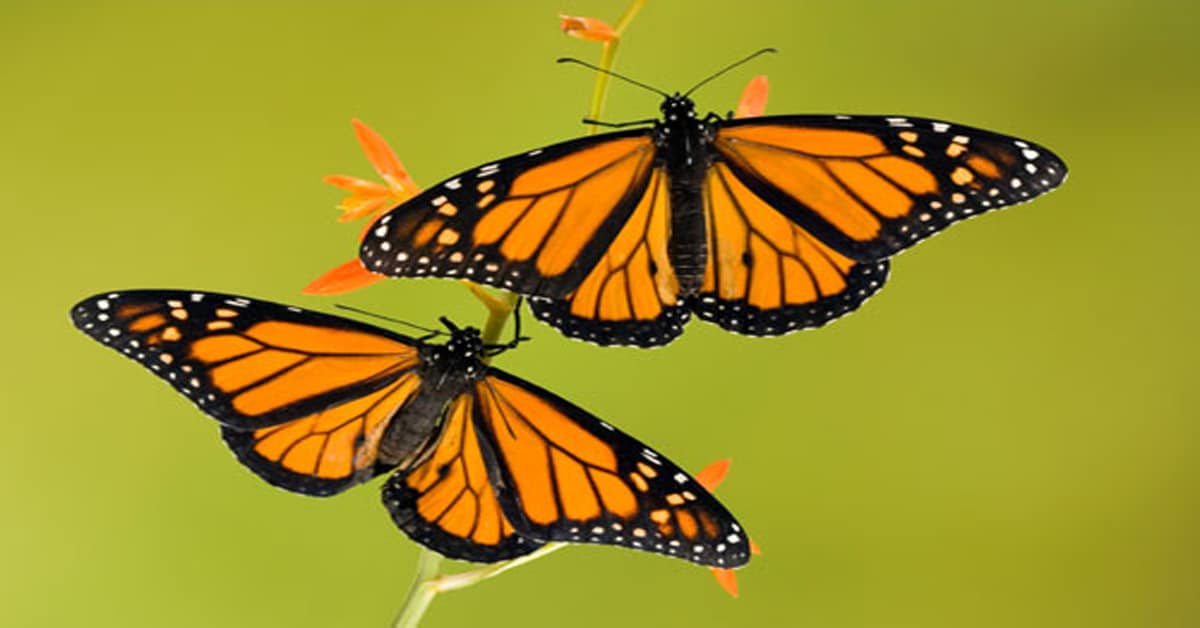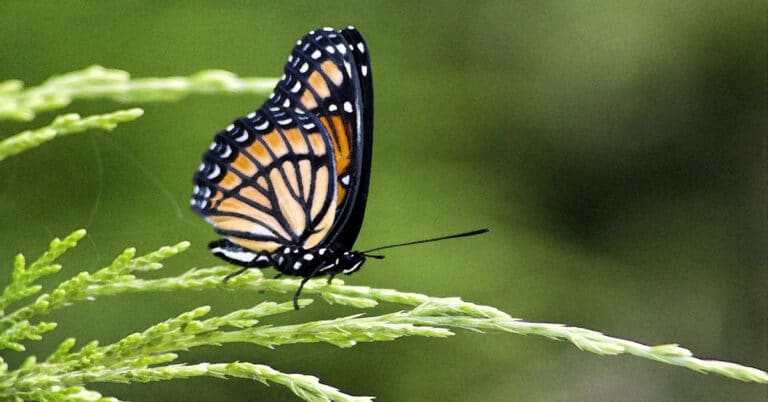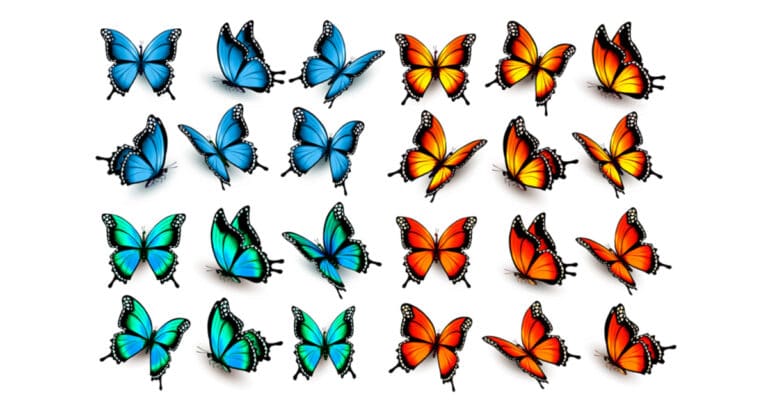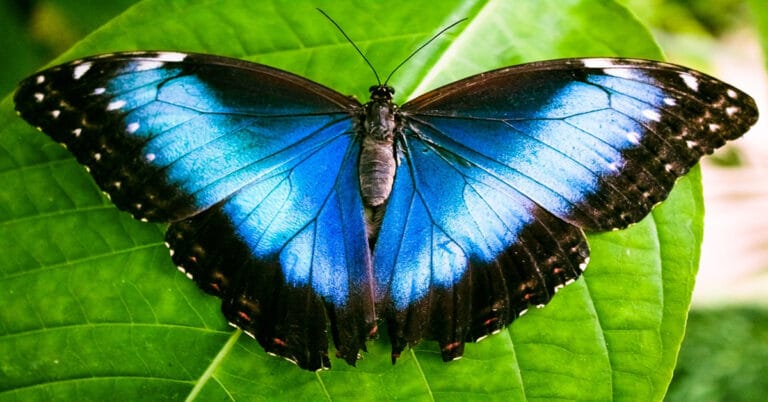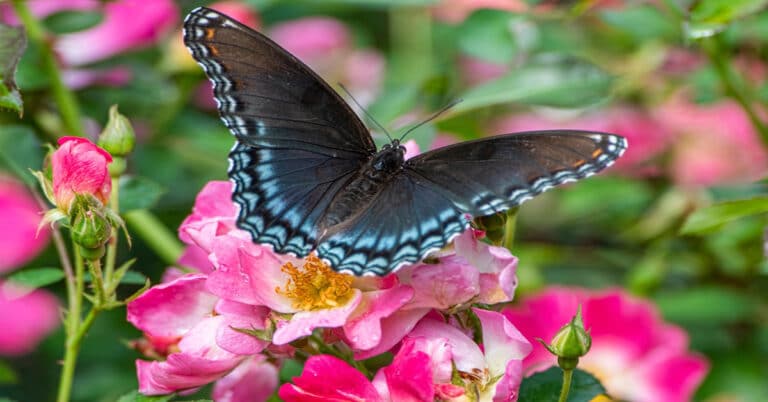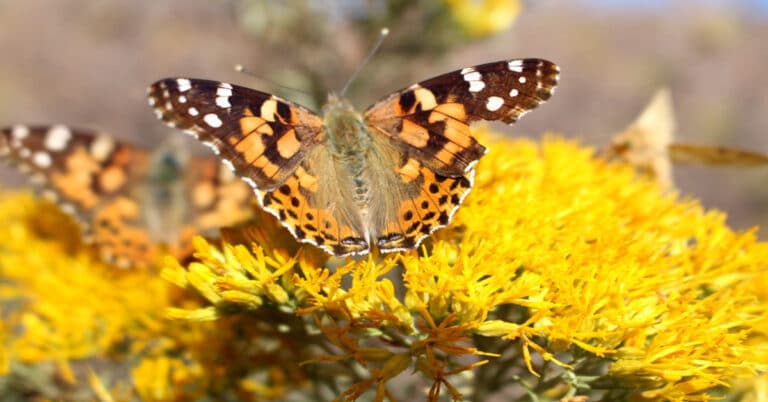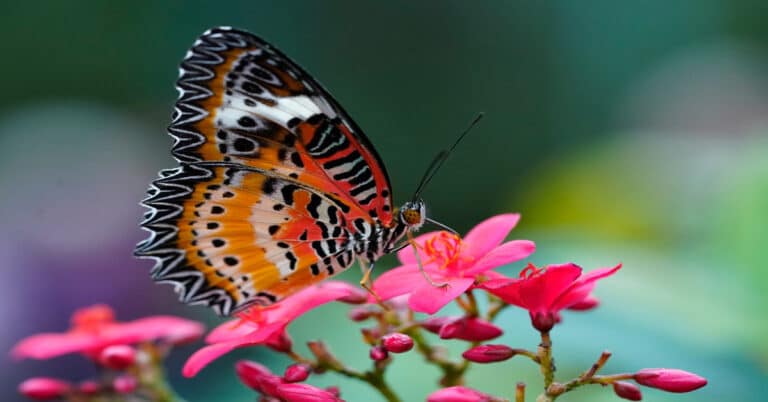Monarch Butterfly Life Cycle
If you have ever been lucky enough to witness Monarch Butterflies fluttering around, you know how captivating they can be. But did you know that the Monarch Butterfly life cycle is just as mesmerizing as its beauty? From egg to caterpillar to chrysalis to adult butterfly, the journey of a Monarch is full of wonder and amazement. In this article, we’ll take a closer look at each stage of the Monarch Butterfly life cycle and uncover some fascinating facts about these incredible insects.
So come along with us on this journey of discovery and learn all about the magical process of the Monarch Butterfly life cycle.
The monarch butterfly life cycle has many stages. This article will examine each stage and help you fly through the monarch butterfly life cycle.
Where Do Monarch Butterflies Live?
Let’s begin our investigation of the Monarch Butterfly life cycle by looking at its habitat. But where exactly do Monarch butterflies live, and what kind of habitat do they prefer?
Monarch butterflies are native to North America, and their range extends from southern Canada all the way down to Mexico. In Canada, they are found as far north as Nova Scotia, while in the United States, they can be found as far south as Florida and as far west as the Rocky Mountains. In Mexico, they are found primarily in the state of Michoacán, where they congregate in vast numbers at a few select overwintering sites.
Monarchs also prefer to live in areas with a mix of open spaces and wooded areas. This allows them to take advantage of the sun’s warmth while still having access to shade and shelter. Monarchs can be found in a variety of habitats, including meadows, fields, and forests, but they are most commonly associated with open grasslands and prairies.
Monarch butterflies are extremely sensitive to changes in temperature and moisture. In general, they prefer warm, sunny weather with temperatures between 60 and 85 degrees Fahrenheit. They also require a certain amount of moisture in the air to survive, but too much humidity can be detrimental to their health.
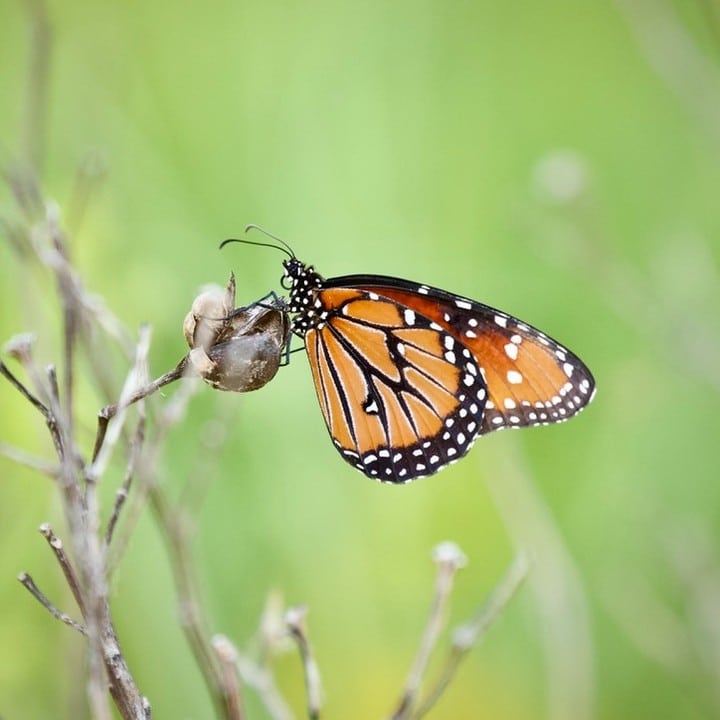
Anatomy of Monarch Butterflies
Before exploring the Monarch Butterfly life cycle, it is essential to also learn more about its anatomy. Their distinctive orange and black wings and delicate, fluttering flight have captivated people for generations. But how much do you really know about the anatomy of these beautiful insects?
At a basic level, monarch butterflies have the same anatomy as other insects. The head contains the eyes, antennae, and mouthparts, while the thorax contains the wings and legs, and the abdomen contains the digestive and reproductive organs.
One of the most notable features of a monarch butterfly’s anatomy is its wings. Monarch butterflies have large, brightly colored wings that are covered in tiny scales. These scales are what give the wings their vibrant orange and black coloration, and they also help to insulate the butterfly’s body, keeping it warm and protected from the elements.
Another important feature of a monarch butterfly’s anatomy is its antennae. These thin, elongated structures are used to sense the environment around the butterfly. They are covered in tiny hairs that can detect changes in temperature, humidity, and other environmental factors.
In addition to their external anatomy, monarch butterflies also have several important internal organs. These include the heart, which pumps blood through the butterfly’s body, and the digestive system, which breaks down food and extracts nutrients.
Overview Of Monarch Butterfly Life Cycle
During its lifetime, an individual Monarch butterfly will have eight completely different outer surfaces in the monarch butterfly life cycle: each in a different size, shape, and color combination. The monarch butterfly life cycle is so quick, four generations will typically complete the life cycle in a year. If you were a monarch, that would mean your great-grandma, your grandma, your mom, and you would all be born in the same year.
Because most butterflies fly for up to two months, the generations overlap to some extent. The final generation (the individuals who hibernate) has a life span of up to eight months. Hibernation is when an animal’s body systems slow way down during the winter. It is almost like a long nap!
One adult female will typically produce 300 to 1100 eggs. A very small percentage of the eggs survive and continue onto the next stage, which tells us something about the survival prospects of a butterfly. The one, two, or ten eggs that become adult butterflies have literally been naturally selected as the fittest to survive out of a thousand.
The monarch butterfly life cycle includes four distinct phases: egg, larva (growing through five changes of skin, or instars), pupa, and adult.
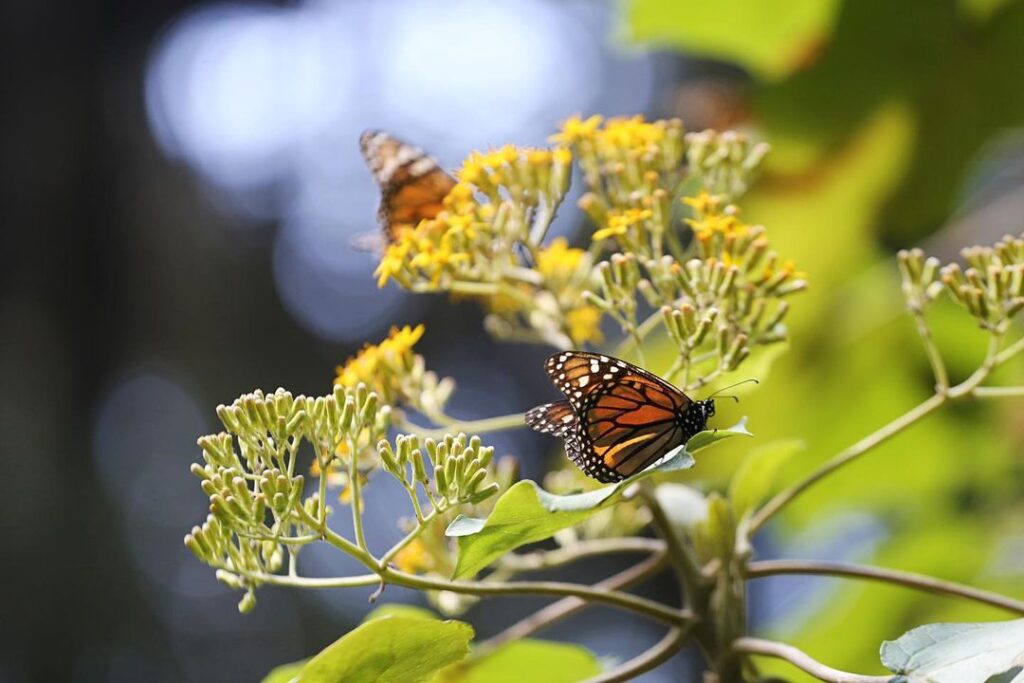
Monarch Butterfly Eggs
If possible, the female Monarch will scout out milkweed plants to lay her eggs. She will place just one egg on each plant and will do this on up to 1,000 different milkweed plants! Why doesn’t she just lay all her eggs on the same plant? Well, it is pretty simple. The mother does not stay to babysit the eggs, nor does she help take care of her young once they hatch. Her only maternal act is to try to give each potential caterpillar enough food for it to eat without destroying its food plant. She lays them separately so the caterpillars will have enough to eat and not have to fight each other for food.
Because the mother monarch does not stick around, she may or may not ever see the baby butterflies hatch from the eggs. She has no noticeable instinct to watch her babies grow up, or interact with them in any way while they are growing.
Monarch butterfly eggs are whitish and egg-shaped. Typically the eggs are a little more than a millimeter long and a little less than a millimeter wide. Bigger butterflies tend to lay bigger eggs, and individuals tend to lay their biggest eggs first. You can see the egg on the underside of a milkweed leaf if one is present. Under a magnifying glass, you might even see the little ridges on the sides of the egg.
Monarch Butterfly Larvae
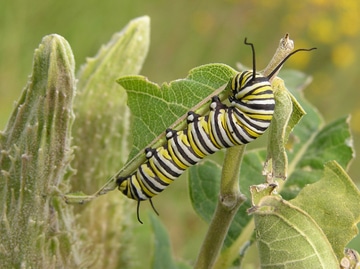
After the eggs are laid, caterpillars (larva) usually hatch in three to eight days starting the next stage in the monarch butterfly life cycle. Monarch hatchlings are nondescript pale greenish animals. Barely two millimeters long when they stretch themselves out of the eggshells, their translucent bodies grow up to six millimeters long during the few days they spend outgrowing their first, drab larval skins.
They are already very hungry caterpillars. As soon as they hatch, they are one the hunt for food. Luckily, the young caterpillars do not have to look far! The first thing they eat is their own empty eggshells, yum!
After consuming the egg they started their life inside, they will no longer need any animal protein. The caterpillars will forget their meal of an animal product and will become vegetarians. Their next mission will be to begin nibbling little holes in milkweed leaves. Milkweed will be their only food.
The larva will begin to change colors and shape in this next small stage in the monarch butterfly life cycle. In the second instar/larva stage, Monarch caterpillars will have tiny bristly hairs on the skin that begins to show bands of yellow, black, and white. This skin grows up to a full centimeter long. Each of these changes of skin normally lasts less than a week.
The third larval skin is striped and begins to develop the distinctive tentacles a Monarch caterpillar uses to flail about and distract predators. To let the caterpillar continue on in the monarch butterfly life cycle, these tentacle will become useful. Some predators will bite off part of a tentacle, giving the caterpillar a chance to escape. During this stage, the caterpillar grows another half centimeter in length and begins to nibble around the edges of milkweed leaves as well as making holes in the middle of the plant.
By the third instar, Monarch caterpillars are starting to change the way they walk. Adult Monarchs have six legs but usually stand and walk on only four, holding their front legs up around their heads. Third instar stage caterpillars will develop this feature, with front legs noticeably shorter than the two other pairs of legs on the thorax. This is similar to most caterpillars. Most of the time, they also have four pairs of prolegs on the abdomen and a pair of claspers at the back end. They will also use their jaws to hold on to things while walking. The tentacles are short and may look like even more legs.
In the fourth instar, the caterpillars finally grow a full inch long. That is about as long as a paperclip! White spots are visible on their prolegs. The tentacles, which remain solid black, grow long enough to be whipped about.
In the final larval stage in the monarch butterfly life cycle, you will see a mature caterpillar. Monarch larvae can be 5 cm long or almost three inches. The caterpillars will weigh as much as 1.5 grams. The tentacles are now quite long and can be lashed dramatically. You may be wondering what being “lashed” means.
Tentacle lashing is basically a stress reaction. Caterpillars reared in captivity will exhibit this behavior more often than wild caterpillars do. Because this is a reaction that happens when a caterpillar is upset, it probably indicates that they feel stressed, rather than that they are waving hello. Wild Monarch caterpillars are likely to climb up onto your hand if you hold out a finger in front of them, while captivity-raised ones may go into fits of tentacle-whipping that probably indicate that they’d prefer to be left alone.
Over the years, humans have studied Caterpillars’ vision. Researchers have determined that they are nearsighted. What does this mean to us? Do we need to take the caterpillars to the eye doctor and purchase them some glasses? Of course not! What is does mean is that because caterpillars can only see very close up, they probably are not able to see all of a human at one time. They truly will not care what you are wearing, because they won’t be able to see your whole outfit!
Monarch caterpillars don’t seem to explore much of the world around them and may spend the whole caterpillar stage of their lives on one milkweed plant. What causes cage-reared caterpillars to seem more stressed than wild ones? It may be that they would much rather live alone. They can sense the presence of other caterpillars in the same cage. They did not ask to have a roommate! Humans are also close by, which again is different that what they are accustomed to in the wild.
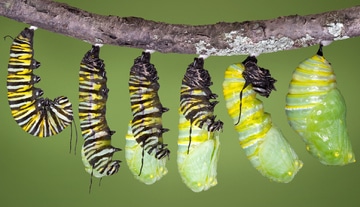
The Monarch Butterfly Chrysalis
All butterflies undergo an extreme makeover in the pupal stage of the monarch butterfly life cycle. When the caterpillars have eaten as much as they can, they stop eating and look for a safe place to rest. Some species of butterfly caterpillars spin cocoons of silk around themselves and then burrow into the ground or hide among dead leaves. Monarch caterpillars do none of these things. They will attach themselves to a little pad of silk to the underside of a sturdy surface. Then they will lock their claspers, hang upside down, curl their heads up toward their midsections, and hang tight waiting.
After about a day in this position, the final larval skin splits and falls off the caterpillar, revealing a smooth, rounded green chrysalis. The chrysalis is a case that goes over the entire body of the caterpillar. There will be no eyes, legs, or any other parts visible. The caterpillar will not be able to move. It shows no signs of life for about two weeks, during which the caterpillar inside is reshaping and transforming itself into a butterfly.
A few predators can attack Monarch chrysalides, these predators can be even smaller than the pupal butterfly. This is another good reason why if you raise butterflies in captivity, environmental scientists recommend not trying to rear a lot of them at one time. Tiny wasps will hunt them down and can bite through the chrysalis and kill the butterfly inside.
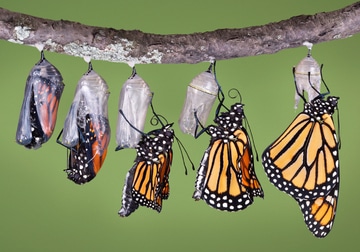
Adult Butterflies
The adult butterfly is sometimes called the imago in the monarch butterfly life cycle. The imago is the image by which the species is best known: orange and black wings with a black outline all tied together with white dots.
The newly transformed adult butterfly crawls slowly out of the back of its chrysalis looking dull, wet, and crumpled. The first experiences of struggling out through the chrysalis and resting on the empty shell for a few hours, are essential in order for the butterfly to have a healthy adult life in the monarch butterfly life cycle.
As you begin watching Monarch butterflies first steps post moving out of the chrysalis, The following will happen. The wings will develop and the colors will brighten. The butterfly will begin an exercise of stretches, flexes, but it will remain on its perch. The perch sitting can often be described as a lesson in patience. These butterflies have bigger, stronger wings than other species and take more time before they are ready to fly.
Adult Monarchs need a lot of space. They don’t form pair bonds; individuals usually mate more than once and flutter about looking for different partners. They will also search for different milkweed plants. Ecologists teach that this behavior pattern is typical of Monarchs. Monarchs need biodiversity to survive and should be allowed to roam naturally rather than farmed or bred in captivity.
While most big moths live entirely on fat stored up from the food they ate as caterpillars, adult butterflies require some food. They eat liquids slurped up through the proboscis, which looks like coarse, curly hair and functions as a drinking straw. They also touch food sources with their feet, which probably have some sense of taste or at least of succulence. How would you like to have taste buds on the bottom of your feet?
Monarchs get most of their nourishment from flower nectar during the adult stage of the monarch butterfly life cycle. They can take nectar from a variety of sources, but their favorite flowers grow on big, tall plants and bear drops of nectar in clumps of narrow tube-shaped petals.
Like many butterflies, Monarchs seem to prefer muddy, polluted water. They need biochemicals from milkweed, which are toxic to most animals, as part of their diet and probably get some benefits from the minerals in mud.
It’s interesting to watch Monarchs flutter and jostle among other butterflies, and other insects, at flowers and puddles. These other insects are neither predators nor competitors, so the Monarchs seem to tolerate their company more than they tolerate other Monarchs’ company. Monarchs like to crowd together only during hibernation. When two Monarchs do fly together, they are usually play-fighting. Males are usually a little bigger than females and sometimes manage to knock them to the ground, which is rougher play than is usually observed in butterflies. (Nevertheless, even Monarchs don’t hurt each other. One observer reported that about one out of three collision flights ended with the participants mating.)
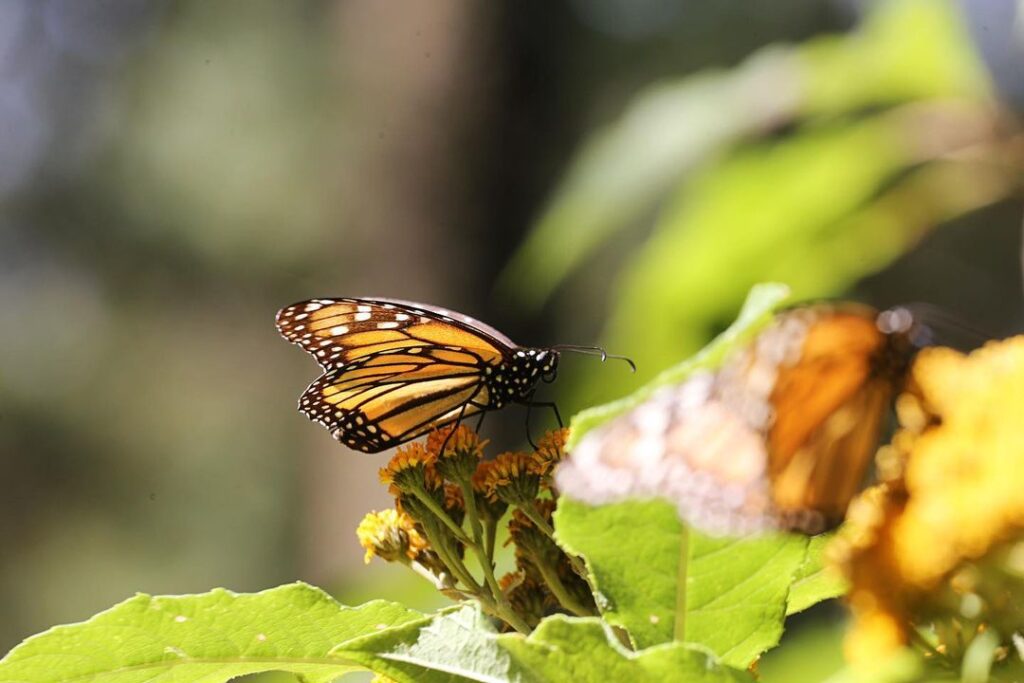
Mating Habits & Reproduction
The Monarch Butterfly life cycle starts with mating and reproduction. As with many other insects, the mating process for Monarch butterflies is quite different from that of mammals. In fact, male Monarchs have a unique way of attracting potential mates: they release a special pheromone that only female butterflies can detect.
When a female Monarch picks up on this scent, she will fly toward the source and engage with the male. Once they are close enough, the male will use his specialized claws to grab onto the female’s abdomen. This is called the “clasp” or “copulation position.” During copulation, the male releases sperm, which the female stores in her body until she is ready to lay her eggs.
Interestingly, the act of copulation can last anywhere from a few seconds to several hours, depending on the circumstances. For instance, if the female is not yet ready to lay her eggs, the male may wait patiently in the copulation position until she is. In some cases, multiple males may even mate with the same female, resulting in a sort of sperm competition for fertilization of her eggs.
It is worth noting that the Monarch Butterfly life cycle is closely tied to the seasonal changes that occur throughout the year. For instance, in the fall, Monarchs will begin to migrate south toward warmer climates, where they will spend the winter months. When they arrive at their destination, they will often mate again before settling down for the season.
In the spring, the Monarch Butterfly life cycle begins anew as the butterflies head back north toward their breeding grounds. Along the way, they will lay their eggs and start the process over again. This cycle of migration and reproduction is critical to the survival of the Monarch species, and it is one of the most fascinating aspects of these beautiful creatures.
The Great Migration
Monarch butterflies are very popular among nature lovers in North America. One reason they are so well known is because they are seen in many different areas of the continent. How does this work? Monarchs move around in a migration pattern throughout the year!
These beautiful creatures will fly up to 2,500 miles in their trip! They begin in Canada, fly all the way though the United States, and end up in Mexico. They complete the mating stage to continue the monarch butterfly life cycle in the beginning or during their trip, somewhere in the USA or Canada. When they get to Mexico, they will stay there over winter and will hibernate.
The Monarch Butterfly life cycle is greatly dependent on the Great Migration. The migration begins in late summer or early fall when the Monarch Butterflies begin to sense the changing seasons. As the days get shorter and the temperatures drop, these butterflies start their journey southward. The journey is divided into several legs, with the first leg taking them to the southern United States. The second leg takes them through Mexico, where they face several obstacles such as strong winds, predators, and natural disasters.
Despite the challenges, Monarch Butterflies manage to reach their wintering grounds in the oyamel fir forests of central Mexico by November. Here, they cluster together in huge numbers, covering entire trees with their colorful wings. These clusters serve as protection from the cold weather and help to conserve their energy.
In the spring, when the weather starts to warm up, the Monarch Butterflies begin their journey northward once again. This journey is just as remarkable as their journey south, but with one crucial difference. Unlike the journey south, which is undertaken by several generations of butterflies, the journey north is undertaken by a single generation of butterflies.
The journey north takes them through Texas and the southern United States, where they mate and lay their eggs on milkweed plants. The next generation of butterflies then continues the journey north, and this process continues until the Monarch Butterflies reach their breeding grounds in Canada.
Unfortunately, the Monarch Butterfly population has been in decline in recent years, mainly due to habitat loss and climate change. As a result, efforts are being made to conserve their habitat and promote their migration journey.
Raising Monarch Butterflies in Terrarium
Raising monarch butterflies in a terrarium can be a wonderful experience that allows you to witness the fascinating Monarch Butterfly Life cycle up close. However, it’s important to note that caring for these delicate creatures does require some knowledge and effort. Let’s take a closer look at how to care for a monarch butterfly in a terrarium.
First, it’s essential to create a suitable environment for monarch butterflies to thrive in. The terrarium should be large enough to allow the butterflies to move around freely, but not so large that it becomes difficult to locate and care for the caterpillars. The bottom of the terrarium should be lined with a layer of paper towel or newspaper to make cleaning easier. You should also place some sticks or twigs for the caterpillars to climb on and form their chrysalises.
Once you’ve set up the environment, you can start the process by collecting monarch butterfly eggs or caterpillars from milkweed plants in your area. It’s important to handle the eggs and caterpillars gently to avoid injuring them.
Next, you’ll need to provide the caterpillars with fresh milkweed leaves every day. As the caterpillars grow, they will consume a large amount of milkweed, so be sure to have a steady supply available. Keeping the terrarium clean and free of debris is also important to prevent the spread of disease.
As the caterpillars develop into chrysalises, it’s important to give them plenty of space to undergo metamorphosis. The chrysalises should be hung from a twig or stick in a safe location, away from any potential disturbances.
Once the butterflies emerge from the chrysalises, you can release them into the wild or keep them in the terrarium for a short period to observe their behavior. Remember, monarch butterflies are migratory insects, so it’s essential to release them into the wild as soon as possible.
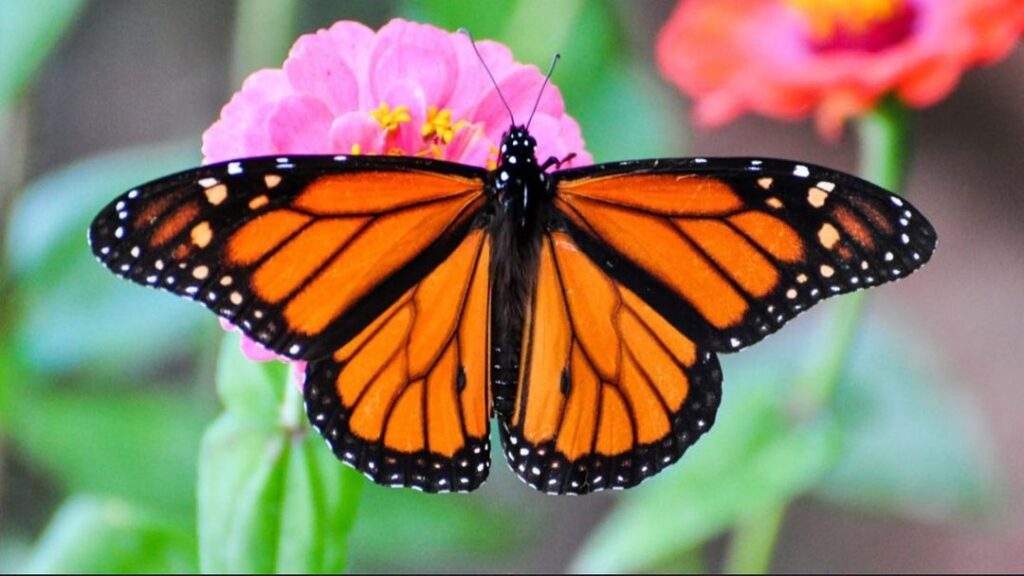
Conservation
Unfortunately, there are some threats to the monarch butterfly species. Because they travel to so many different places in the monarch butterfly life cycle, they are susceptible to habitat change caused by humans. Because of city expansion, monarchs are losing their natural habitat.
Other factors that are taking the natural habitat away from monarchs is climate change and farming. While farmers mean well when they spray milkweed to keep it out of their fields, it is detrimental to the monarch butterfly life cycle. Farmers are trying to feed humans and other animals by growing our food, and milkweed is a nuisance in doing so. Thus, they take precautions to get rid of the milkweed to help their own crops.
When farmers spray the milkweed, is takes out the home for the eggs in the monarch butterfly life cycle. Climate change is affecting the butterflies because the new weather patterns make it difficult for the animals to know when to migrate, after all the butterflies do now carry a calendar around! If the butterflies do not migrate at the proper time, they may get caught in a cold spell before they make it to Mexico and will die. This will put a halt to the monarch butterfly life cycle for the next generation.
Although the future may sound grim, there is hope for the monarch butterflies. There are efforts currently being made to plant more native plants that they feed on in the adult stage of the monarch butterfly life cycle. You can help by planting wildflowers in your flower beds, and gardens, or even just putting a pot with a few plants outside! If you have milkweed, you can also make sure you do not destroy it and leave a place for the eggs to sit in the monarch butterfly life cycle.
Bottom Line
In this article, we explored the fascinating Monarch Butterfly life cycle, from the tiny egg to the beautiful butterfly. We’ve seen how this incredible creature transforms through the Monarch Butterfly life cycle. It’s truly amazing how such a small and delicate insect can undergo such an incredible metamorphosis. Next time you spot a monarch butterfly fluttering by, take a moment to appreciate the incredible journey it has been through.
We hope you enjoyed learning about the Monarch Butterfly life cycle and gained a deeper appreciation for the wonders of nature.
If you have enjoyed this article and would like to color your own butterfly, click here for printable Monarch Butterfly Life Cycle Coloring Pages. You can find more butterflies to learn about there.

Nato is a content writer and researcher with a background in psychology who’s eager to explore the wonders of nature. As a travel enthusiast and animal lover, she hopes to inspire others to discover and cherish the beauty and importance of the natural world.

